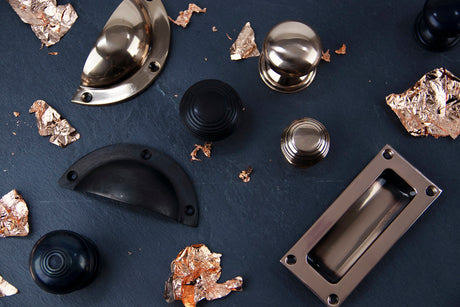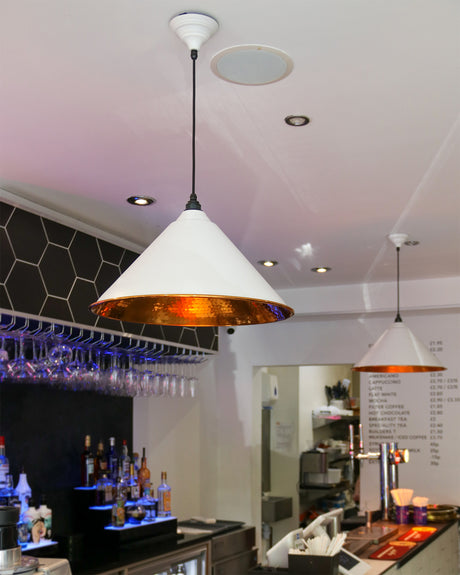Carlisle Brass Materials – Understanding the Metals Behind Quality Ironmongery
When choosing architectural hardware, the quality of Carlisle Brass Materials makes all the difference. Design and finish are important, but the metal beneath determines strength, corrosion resistance, and how long your ironmongery will last.
Supplied by Trade Door Handles, trusted UK supplier of architectural ironmongery since 1976, with quick nationwide delivery.
This detailed guide explains the Carlisle Brass Materials used in door handles, hinges, locks, and fittings — including brass, zinc alloy, stainless steel, malleable iron, and aluminium. By understanding each Carlisle Brass Material, you can choose hardware that performs beautifully in both residential and commercial environments.
Carlisle Brass is one of the UK’s leading manufacturers of architectural ironmongery. Their reputation for consistency and innovation is built on the quality of their materials. You can explore every range of Carlisle Brass Materials within our Carlisle Brass Door Handles and Hardware collection.
Why Carlisle Brass Materials Matter
Different Carlisle Brass Materials deliver unique performance benefits:
Durability: resistance to everyday wear and environmental exposure
Corrosion protection: vital for bathrooms, kitchens, and coastal areas
Finish quality: how evenly coatings and plating adhere
Weight and balance: influencing both tactile feel and longevity
Even when two handles look identical, the underlying Carlisle Brass Material dictates quality. A polished chrome lever in solid brass will always outlast one made from zinc alloy.
Brass
Of all Carlisle Brass Materials, brass remains the premium choice for its strength, beauty, and adaptability. Used across collections such as Delemaine, Manital, and Alexander & Wilks, solid brass is the foundation for many of Carlisle Brass’s finest designs, available from Carlisle Brass Door Handles and Knobs.
Brass is perfect for casting decorative shapes, allowing Carlisle Brass Materials to feature detailed levers, smooth curves, and heritage-style patterns. Its density and weight give every product a luxurious feel.
Advantages of Brass as a Carlisle Brass Material:
Exceptional corrosion resistance and long life
Allows intricate design thanks to the casting process
Provides the best surface for electroplating (Chrome, Brass, Nickel, or Bronze)
Finishes adhere evenly and last longer
Feels heavy, solid, and premium in hand
Why Brass Outperforms Zinc:
Because brass is denser, plating adheres smoothly and resists moisture penetration. Zinc can show microscopic imperfections, allowing water to ingress and begin deterioration more quickly. This is why many Carlisle Brass Materials use brass for flagship collections — it simply plates and polishes better.
Best For:
Ideal for front doors, period homes, and luxury interiors. Pair brass handles with our Carlisle Brass Door Furniture Accessories to create timeless style.
Zinc Alloy
Zinc alloy is one of the most commonly used Carlisle Brass Materials, chosen for its affordability and versatility in modern hardware design. As a casting metal, zinc alloy allows Carlisle Brass to create sleek, contemporary shapes at a lower cost than solid brass — without sacrificing style.
This particular Carlisle Brass Material is ideal for smooth and minimalist levers, escutcheons, and accessories. It provides excellent moulding precision, making it a top choice for consistent, uniform shapes across large production runs.
Advantages of Zinc Alloy as a Carlisle Brass Material:
A lightweight and flexible option among Carlisle Brass Materials
Cost-effective for both residential and commercial interiors
Allows intricate casting detail for modern handle designs
Accepts a wide range of finishes, from Polished Chrome to Matt Black and Satin Brass
Perfect balance between affordability and visual appeal
However, because zinc is more porous than brass, finishes don’t bond quite as tightly. Moisture can penetrate small imperfections over time, leading to dulling or pitting. For this reason, Carlisle Brass Materials made from zinc are best reserved for internal doors and dry environments.
Best For:
Zinc alloy Carlisle Brass Materials are ideal for bedrooms, hallways, and living areas — anywhere protected from humidity. Explore zinc-based options within our Carlisle Brass Door Handles and Hardware range to see how this adaptable Carlisle Brass Material performs in everyday interiors.
Stainless Steel
Stainless steel is one of the most durable Carlisle Brass Materials, known for longevity, hygiene, and corrosion resistance. It’s used throughout commercial and domestic projects, from heavy-duty hinges to sleek door levers.
Carlisle Brass manufactures several grades of stainless steel:
Grade 201 – economical choice for interior use and dry conditions
Grade 304 – all-purpose grade for kitchens and bathrooms
Grade 316 – marine-grade for external and coastal environments
Why Stainless Steel Excels Among Carlisle Brass Materials:
Resists rust, tarnish, and atmospheric corrosion
Ideal for high-humidity or salt-air regions
Minimal maintenance — just wipe clean
Sleek, modern appearance suits contemporary homes
Best For:
Choose 316 stainless steel for coastal properties, 304 for bathrooms and kitchens, and 201 for internal doors. You’ll find many stainless options in our Carlisle Brass Hinges and EuroSpec ranges — both made from premium Carlisle Brass Materials.

Malleable Iron
Malleable iron offers heritage appeal and outstanding durability, earning its place among trusted Carlisle Brass Materials.
Advantages of Malleable Iron:
Extremely tough and impact-resistant
Authentic texture ideal for traditional homes
Often finished in Ludlow Antique Black for protection
Best For:
Perfect for barn conversions, cottages, and rustic interiors. The Carlisle Brass Accessories range features many examples of this classic material.

Aluminium
Aluminium is another key metal within the Carlisle Brass Materials range. It’s strong, lightweight, and naturally resistant to corrosion, making it a superb choice for interior fittings. As a non-ferrous metal, aluminium forms its own protective oxide layer, giving it impressive durability even without coating — a clear benefit among all Carlisle Brass Materials.
Advantages of Aluminium as a Carlisle Brass Material:
Naturally rust-resistant with minimal maintenance
Excellent for slim, modern, or minimalist handle profiles
Easy to machine and finish in multiple colours
Lightweight yet durable — perfect for frequent use
Fully recyclable, making it one of the most sustainable Carlisle Brass Materials
Aluminium’s clean aesthetic suits kitchens, wardrobes, and cabinet hardware beautifully. It’s widely used across the Carlisle Brass Kitchen and Cabinet Hardware collection, showcasing how Carlisle Brass Materials can deliver a modern look with lasting practicality.
Best For:
Choose aluminium Carlisle Brass Materials when you need lightweight strength — especially in cabinetry, drawers, and kitchen fittings that demand both design and endurance.

Understanding PVD Finishes
Several Carlisle Brass Materials — especially brass and stainless steel — are enhanced by PVD (Physical Vapour Deposition) coatings. PVD creates a hard, molecular-level bond to the surface, making finishes far more resistant to wear and corrosion.
Benefits of PVD:
Long-lasting colour and gloss retention
Excellent scratch resistance
Environmentally friendly coating method
Available in Satin Brass, Matt Black, and Bronze
You’ll find PVD coatings applied across our Carlisle Brass Locks and Latches — a sign of advanced technology used throughout premium Carlisle Brass Materials.
Brass vs Zinc – Comparing Carlisle Brass Materials
When comparing Carlisle Brass Materials, the difference between brass and zinc is significant. Brass is the premium option — dense, heavy, and naturally corrosion-resistant — while zinc is lighter, more affordable, and easier to cast into modern designs.
Both Carlisle Brass Materials serve their purpose, but brass offers a longer lifespan and superior plating quality. Because brass has a smoother, denser surface, it bonds perfectly with finishes like Polished Chrome, Antique Brass, and Satin Nickel. Zinc’s porous texture, by contrast, can create tiny imperfections in plating, allowing water ingress and early deterioration.
This is why many premium Carlisle Brass Materials use brass as their foundation — especially for high-end handles, locks, and door furniture designed for longevity.
Quick Comparison of These Carlisle Brass Materials:
Brass: Heavy, luxurious, corrosion-resistant, and perfect for exterior doors or heritage settings.
Zinc Alloy: Lightweight, cost-effective, and ideal for internal use, though not suited to outdoor conditions.
For timeless quality and extended lifespan, brass remains the superior Carlisle Brass Material. However, zinc still provides a stylish and affordable entry point within the Carlisle Brass Materials family, ideal for contemporary interiors. Explore both in our Carlisle Brass Door Handles and Hardware collection.
Guarantees and Maintenance
Carlisle Brass stands behind its materials. Most Carlisle Brass Materials include long-term mechanical guarantees, and many stainless or PVD finishes come with finish warranties of up to 25 years.
Maintenance Tips:
Clean gently with mild soap and warm water.
Avoid harsh chemical sprays.
Dry surfaces thoroughly to prevent residue.
Polish unlacquered brass occasionally with a soft cloth.
Proper care ensures every Carlisle Brass Material performs at its best.

Summary
Understanding Carlisle Brass Materials ensures you choose fittings that match your environment and style:
At Trade Door Handles, we’ve supplied Carlisle Brass Materials to customers nationwide for nearly 50 years. Whether you’re working on a refurbishment, new build, or commercial project, our expert team can recommend the best Carlisle Brass Materials for any setting.
Brass – premium, corrosion-resistant, perfect for intricate design
Zinc Alloy – affordable and versatile for interiors
Stainless Steel – high strength, ideal for bathrooms or coastal homes
Malleable Iron – heritage durability
Aluminium – lightweight and modern
PVD Finishes – protective coating for long-lasting beauty
Frequently Asked Questions
What materials does Carlisle Brass use?
Carlisle Brass manufactures with brass, zinc alloy, stainless steel, malleable iron, and aluminium. These Carlisle Brass Materials cover everything from traditional fittings to commercial hardware.
Why does brass plate better than zinc?
Brass provides a smooth, dense surface that bonds perfectly to plating. Zinc’s porous texture can allow moisture in, causing quicker wear — another reason Carlisle Brass Materials rely heavily on brass.
What’s the difference between 201, 304, and 316 stainless steel?
Each grade offers unique benefits: 201 is for interior use, 304 for kitchens and bathrooms, and 316 for coastal or outdoor environments. All are part of Carlisle Brass’s premium stainless-steel materials portfolio.
Which Carlisle Brass Materials are best for outdoor use?
The most suitable are 316 stainless steel, brass, and PVD-coated finishes, as they resist rust and environmental damage.
Are door handles made from zinc suitable for outside use?
In truth, zinc handles are not recommended for exterior doors. Zinc alloys are more porous and prone to corrosion when exposed to moisture and temperature changes. However, some people still use zinc handles outdoors as a cost-effective option, especially when they prefer a modern finish instead of Polished Brass (PVD) or Stainless Steel. Just be aware that long-term exposure will cause the finish to deteriorate much faster.
Do Carlisle Brass finishes come with guarantees?
Most Carlisle Brass Materials are covered by a mechanical guarantee, which protects the product’s operation rather than its finish. The truth is that very few manufacturers in the industry guarantee surface finishes, because there are so many external factors that can affect them.
Finish deterioration depends on cleaning chemicals, environmental exposure, humidity, and everyday handling. Even premium finishes like polished brass, lacquered chrome, or black coatings can tarnish or fade faster if exposed to moisture, salt air, or abrasive cleaners.
That said, PVD-coated and stainless-steel finishes are far more resilient. They typically last many years with minimal maintenance — even without a formal finish guarantee — which is why they’re preferred for coastal and commercial applications.








